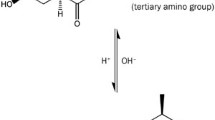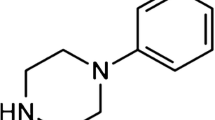Summary
The purpose of the study was to go further into the transepithetial transport of bepridil, an anticalcic agent, through monolayer cells Caco-2, using a “dynamic model” including a transfer of inserts with Caco-2 cells into new wells, free of drug, at regular intervals, in order to simulate the blood flux. The state of cells was evaluated by measuring the transepithelial electrical resistance and the transport of bepridil was followed using a gas chromatography/mass spectrometry determination. This study exhibits the importance of the basolateral renewal both on the trasport of bepridil and the maintenance of cells in a satisfactory state. Two elimination phases from the cell compartment seem to occur, with basolateral half lives respectively of 12.2 and 25.6 hours, probably linked with two kinds of cellular binding sites. This dynamic model permits the reflection and simulation of the slowness of the in vivo absorption of bepridil in the small intestine.
Similar content being viewed by others
References
Boulenc X. (1997): Intestinal cell models. Their use in evaluating the metabolism and absorption of xenobiotics. STP. Pharm. Sci., 7(4), 259–269.
Stammati A, Badino P, De Angelis I et al. (1997):in vitro toxicity and formation of early conjugates in Caco-2 cell line treated with clenbuterol, salbutamol and isoxsuprine. Eur. J. Drug Metab. Pharmacokinet., 22(2), 173–178.
Buur A, Trier L., Magnusson C, Artursson P. (1996): Permeability of 5-fluorouracil and prodrugs in Caco-2 cell monolayers. Int. J. Pharm., 129, 223–231.
Chong S, Dando SA, Soucek KM, Morison RA (1996):in vitro permeability through Caco-2 cells is not quantitatively predictive ofin vivo absorption for peptide-like drugs absorbed via the dipeptide transporter system. Pharm. Res., 13(1), 120–123.
Cogburn J N, Donovan MG, Schasteen CS (1991): A model of human small intestinal absorptive cells. 1. Transport barrier. Pharm. Res., 8(2), 210–216.
Collett A, Sims E, Walker D, et al. (1996): Comparison of HT29-18-C1 and Caco-2 cell lines as models for studying intestinal paracellular drug absorption. Pharm. Res., 13(2), 216–221.
Hilgers AR, Conradi RA, Burton PS. (1990): Caco-2 cell monolayers as a model for drug transport across the intestinal mucosa. Pharm. Res., 7(9), 902–910.
Karlsson J, Kuo S-M., Ziemniak J, Artursson P. (1993): Transport of celiprolol across human intestinal epithelial (Caco-2) cells: mediation of secretion by multiple transporters including P-glycoprotein. Br. J. Pharmacol., 110, 1009–1016.
Lindmark T, Nikkilä T, Artursson P. (1995): Mechanisms of absorption enhancement by medium chain fatty acids in intestinal epithelial Caco-2 cell monolayers. J. Pharmacol. Exp. Th., 275(2), 958–964.
Raub TJ, Barsuhn CL, Williams LR, Decker DE, Sawada GA, Ho NFH. (1993): Use of a biophysical-kinetic model to inderstand the roles of protein binding and membrane partitioning on passive diffusion of highly lipophilic molecules across cellular barriers. J. Drug Target., 1, 269–286
Krishna G, Chen K, Lin C-C, Nomeir A-A. (2001): Permeability of lipophilic compounds in drug discovery using in-vitro human absorption model, Caco-2. Int. J. Pharm., 222, 77–89.
Sawada GA, Ho NFH, Williams LR, Barsuhn CL, Raub TJ. (1994): Transcellular Permeability of Chlorpromazine Demonstrating the Roles of Protein Binding and Membrane Partitioning. Pharm. Res., 11(5), 665–673.
Tillement JP, Albengres E, Lhost F. (1982): Bepridil. Rev. Med., 23, 1637–1640.
Mathieu F, Galmier M-J, Pognat J-F, Petit J, Lartigue C. (1999): Transepithelial transport of bepridil in the human cell line, Caco-2, using two media DMEMc and HBSS. Int. J. Pharm., 181, 203–217.
Sakai M, Noach A-B, Blom-Roosemalen M-C-M, De Boer A-G, Breimer D-D. (1994): Absorption enhancement of hydrophilic compounds by verapamil in Caco-2 cell monolayers. Biochem. Pharmacol., 48(6), 1199–1210.
Stenson W-F, Easom R-A, Riehl T-E, Turk J. (1993): Regulation of paracellular permeability in Caco-2 cell monolayers by protein kinase C. Am. J. Physiol., 265, G955-G962
Author information
Authors and Affiliations
Rights and permissions
About this article
Cite this article
Mathieu, F., Galmier, M.J., Nicolay, A. et al. Transepithelial transport of bepridil in the human intestinal cell line, Caco-2, using a “dynamic model”. Eur. J. Drug Metab. Pharmacokinet. 28, 155–160 (2003). https://doi.org/10.1007/BF03190505
Received:
Issue Date:
DOI: https://doi.org/10.1007/BF03190505




